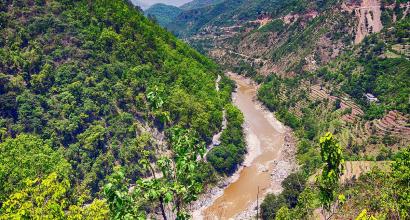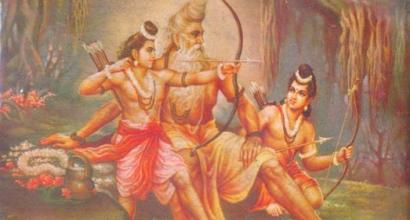With great delight Arjuna looked at the Kaurava heroes retreating; he bowed his head down and offered his greetings to Grandfather Bhīṣma and Ācārya Droṇa and rode with them for some distance, engaging in casual conversation. Then he paid his respects to Aśvatthāma, Kṛpa, and others by hurling an arrow at them [at their feet]; then he shot an arrow at Duryodhana’s bejewelled crown and tore it apart. Finally, he twanged the string of the Gāṇḍīva, blew his conch Devadatta, and after all the enemies had left, told Uttara, “O Prince, now make the steeds turn the chariot, we have won back the cows. All of them have retreated; with joy, ride back to the capital.” While they were on the way, Kaurava soldiers who had hidden themselves in different parts of the forest out of fear slowly came out of their hiding places into the open, bowed down to Arjuna and asked, “What are your orders for us?” Having come to a foreign land, they had become weak and decrepit, after being overwhelmed by hunger and thirst; looking at these helpless soldiers, Arjuna offered them solace with the words: “Best wishes to you, please go on your way, don’t be afraid! I don’t harm the weak and the helpless.” Hearing those words that assuaged their fears, the soldiers blessed him with long life and great success before they went on their way. Arjuna told Uttara, “Prince, send the cows along with these cowherds; they will reach the city first; let them delight everyone by narrating the tale of your bravery and victory! We shall give the horses water to drink, tend to them, and return to the capital in the afternoon.” Accordingly, Uttara called his messengers and ordered them to return to the capital and announce his victorious campaign.
At the other end of the kingdom, Virāṭa had defeated the Trigartas, freed the cows from their clutches, and returned to the capital accompanied by the other four Pāṇḍavas. Once he sat down on the throne, all his subjects came to see him and offer their respects and admiration; they congratulated him on his victory. After he bade them farewell, he asked, “Where is Uttara?” All the womenfolk, the young girls, and the servants of the inner quarters said with great aplomb, “The Kauravas captured our cows. We learnt that several great warriors including Droṇa, Bhīṣma, Karṇa, Aśvatthāma, and Duryodhana arrived on the battlefield. With a great spirit of adventure and valour, Uttarakumāra went to the battlefield with Bṛhannaḻa as his chariot-driver to defeat all the Kauravas single-handedly.” Virāṭa was visibly upset upon listening to this news and he trembled. “The Kauravas will not be able to control themselves if they learn that the king of Trigarta has been defeated. Whatever be the case, let all those warriors who were not injured in the battle with the Trigartas go at once to the aid of my son!” ordered Virāṭa as he also called for the four limbs of the army [elephantry, chariotry, cavalry, and infantry] to accompany them at once and with great speed. Then he said, “Find out at once if my son is dead or alive and share the news with me; somehow I get the feeling that with a eunuch as a charioteer, he might not have survived!” Upon listening to those words, Dharmarāja said with a laugh, “O king! If Bṛhannaḻa is driving his chariot, then the enemies cannot take the cows and go away; with the help of that charioteer your son will be able to defeat all the Kauravas, all the kings [of earth], Devas, Asuras, Yakṣas, and Nāgas.” In the meantime, the messengers sent by Uttara rushed to the king and shared the news of his victory. Kaṅka heard that and said, “It is great fortune that your son has returned alive. He has freed the cows and is bringing them back! But I don’t find any surprise in this; when Bṛhannaḻa is the charioteer then victory is certain!” Virāṭa was overjoyed and his hairs stood on end; he gave away many rewards to the messengers who had brought the good news. Turning to his ministers, he said, “Decorate the royal path with flags and festoons! Offer worship to the deities! Let all the princes, army officials, courtesans, and all the instrument-players welcome the crown prince! Let messengers go around the city atop elephants ringing bells, playing drums, and announcing my victory! Let Uttarā and other girls dress beautifully with all their ornaments and welcome Bṛhannaḻa.” Having thus ordered them, Virāṭa said with great joy, “Sairandhrī, go and bring the game of dice! Come Kaṅka, let’s play a game!” But in response, Kaṅka said, “It is said that one must not gamble with a person who is overjoyed and swelling with happiness. Therefore I don’t have the heart to play a game of dice with you. If there is anything else that will gladden your heart, let me know and I shall do that for you!” Virāṭa said, “Is there any beautiful thing that I desire from you? I don’t desire women, nor do I desire gold; I don’t want cows, nor do I want riches! I don’t want anything other than a good game of dice!” Kaṅka said, “What’s the need to gamble now, O great king? It is a terrible vice. Haven’t you heard how Yudhiṣṭhira gambled and lost his expansive kingdom, all his wealth, and his deity-like brothers? In spite of all this, if you still insist on gambling, then I shall play.” The king insisted. The game began. In the middle of the game, Virāṭa said, “See how my son defeated all those Kauravas and has come out a winner!” Dharmarāja replied, “With Bṛhannaḻa as the charioteer, how could he not emerge victorious?” Listening to these words Virāṭa was angered. He roared, “O lowly brāhmaṇa! Instead of praising my son, you are showering praises on that eunuch! Without realizing what must be spoken and what must not, you are insulting me. Why can’t my son defeat Bhīṣma, Droṇa, and the rest? Hey brāhmaṇa, keeping in mind your age, I am forgiving you for this transgression. If you desire to live, then don’t utter such words again!” Dharmarāja said, “When great warriors like Droṇa, Bhīṣma, Aśvatthāma, Karṇa, Kṛpa, Duryodhana and others have come together at one place, if not Bṛhannaḻa, who else could have stood there and waged war with them?” Enraged, Virāṭa said, “In spite of repeated warnings, you are sticking to your words; without punishment, who indeed treads the right path! What you say would have never happened! Fie upon you!” With these words, Virāṭa forcefully hurled the dice at Yudhiṣṭhira’s face. The dice struck him hard and with that impact, his nose started bleeding profusely. Yudhiṣṭhira cupped both his hands to stop the blood from touching the ground and cast a glance at Draupadī, who was nearby. She instantly understood what was going on in his mind and brought a golden bowl to collect the blood that was oozing out.
To be continued…
This is an English translation of Prof. A R Krishna Shastri’s Kannada classic Vacanabhārata by Arjun Bharadwaj and Hari Ravikumar published in a serialized form. Thanks to Śatāvadhāni Dr. R Ganesh for his review and astute feedback.












































